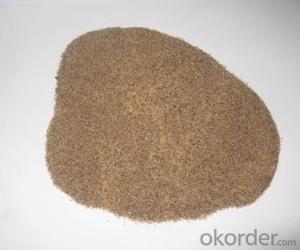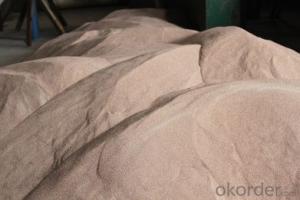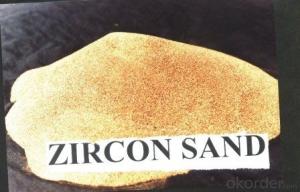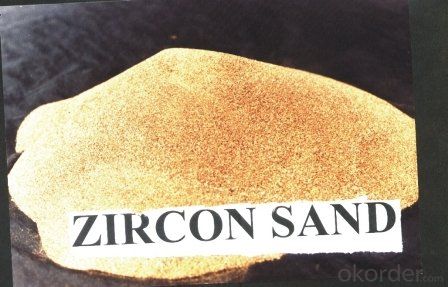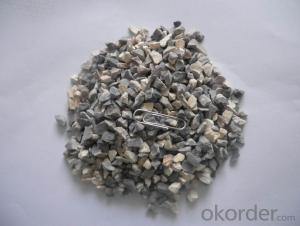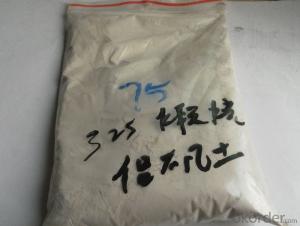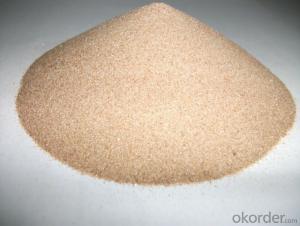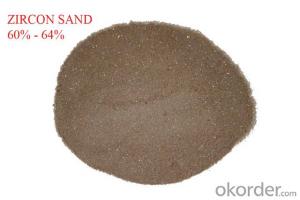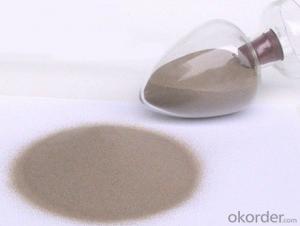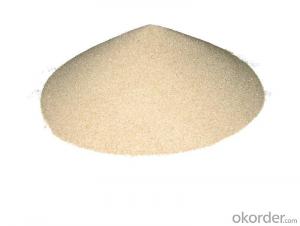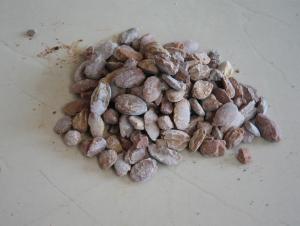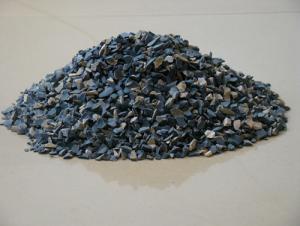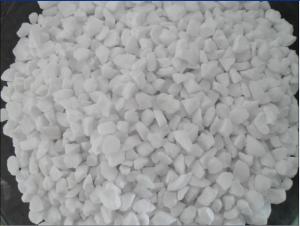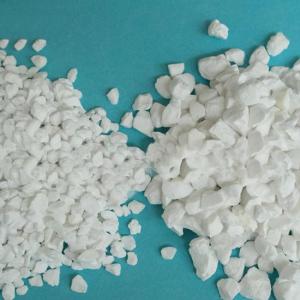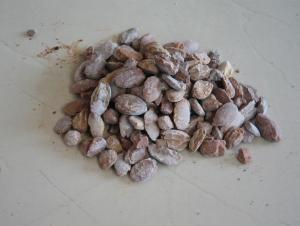Raw Materials for Refractory:High Performance Zircon Sand and Zircon Flour Powder
- Loading Port:
- Tianjin
- Payment Terms:
- TT OR LC
- Min Order Qty:
- 25 m.t.
- Supply Capability:
- 3000 m.t./month
OKorder Service Pledge
OKorder Financial Service
You Might Also Like
Refractory Material/ Zircon Sand and Zircon Flour Powder Good Performance
1.Structure of Zircon Sand and Zircon Powder
We are offer zircon sand With Below Mention Descriptions: ZrO2 65 - 67 %. We are offer zircon sand With Below Mention Descriptions: ZrO2 65 - 67 %. Zircon is a remarkable mineral, if only for its almost ubiquitous presence in the crust of Earth. It occurs in igneous rocks as primary crystallization products, in metamorphic rocks and in sedimentary rocks as detrital grains.
Further, the mineral due to hardness, durability and chemical inertness, zircon persists in sedimentary deposits and is a common constituent of most sands.
2.Main Features of Zircon Sand and Zircon Powder
1 Tiny, round, solid ball shape provides greater surface area for improved performance and dispersion in its application
2 High refractory rating, lower specific gravity rating, and higher service temperature produces greater yield
3 With lower bulk density, it offers better air permeability for better performance as a result of its overall physical characteristics
3.Main usage of Zircon Sand and Zircon Powder
Ceramic Industries – Wall Tiles , Floor Tiles , Roofing Tiles
Sanitary Ware Industries
Pottery Industries
Porcelain Glazes
Frit for Glaze and Enamels
Ceramic Colour Industries
Admixture for Glass , Opal Glass
Picture Tube Industries
Foundries , Investment Casting Industries
Special Refractories , Castable Refractories
Zircon Bricks , Zirconium Oxide Industries
Epoxy Resin , Special Paints Industries
4. Zircon Sand and Zircon Powder Images
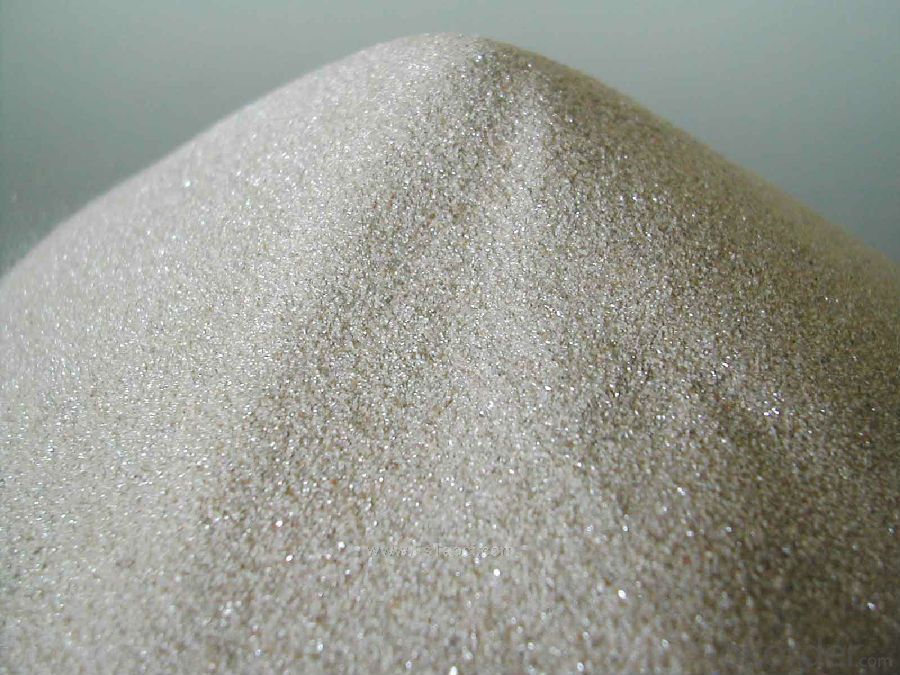
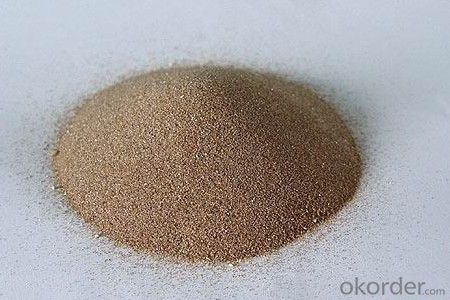
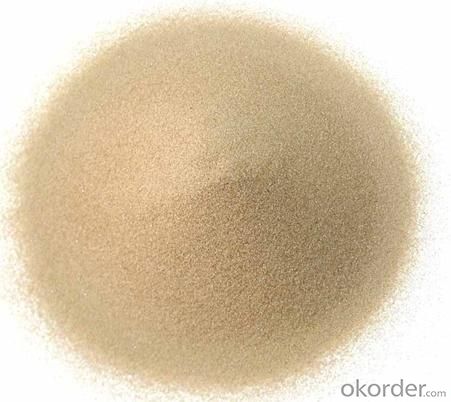
5. Zircon Sand and Zircon Powder Specification
| Grade | Zr | Fe | Ti |
| A | 66min | 0.06max | 0.08max |
| B | 65.5min | 0.1max | 0.1max |
| C | 65min | 0.15max | 0.2ma |
6.FAQ of Zircon Sand and Zircon Powder
1). Q: Are you a factory or trading company?
A: We are a factory.
2). Q: Where is your factory located? How can I visit there?
A: Our factory is located in China. You are warmly welcomed to visit us!
3). Q: How can I get some samples?
A: Please contact me for samples
- Q: What are the refractory stocks?
- The company produces energy saving, environmental protection type functional refractory materials and unshaped refractory materials. It is the main functional refractory material and unshaped refractory production enterprise in china. Company's products to new green high-quality refractory materials, energy saving and environmental protection as the leading iron and steel industry technological progress and improve the level of technology and equipment to adapt to meet the "development policy" refractories industry to develop industry, has a strong competitive advantage in the market. The main domestic refractory products company can only use part of the products of refractory materials production of iron and steel industry, iron and steel industry production and Pu resistant can be used in the vast majority of refractory products, iron and steel industry with the most complete refractory products. Therefore, the future development of the company is closely related to the prosperity of the iron and steel industry. More than more than 2000 enterprises in refractory industry, the company is the largest supplier of refractory materials in China, and the market share is less than 2%. Iron and steel group integration will inevitably lead to the overall contract cost control, supplier refractory decreases by seventy or eighty to two or three. The company's overall contract accounted for 37% (Montreal 68%), the overall contract increase will enhance the market share and profitability. China's urbanization, industrialization and investment in the 4 trillion infrastructure will stimulate sustained and rapid growth of China's steel demand. Therefore, in the long run, the prospects for the development of refractories for iron and steel are broad.
- Q: Who knows about roof fireproofing materials?
- At present, only phenolic foam boards can meet requirements. The test temperature can be 2,000 degrees, and there is no molten droplet during the tests and it can maintain integrity. heat conductivity coefficient: 0.03W / (mk), non-combustible, non-toxic, smokeless!
- Q: Does anyone know the difference between refractory and thermal insulation material?
- The main difference between insulation bricks and refractory bricks are as follows: 1. Insulation effect The heat conductivity cofficient of insulation bricks is usually 0.2-0.4 (average temperature of 350 ± 25 ℃) w / mk while the heat conductivity coefficient of refractory bricks is 1.0 (average temperature of 350 ± 25 ℃) w / mk or more. Thus it can be seen that the insulation effect of insulation bricks is much better than that of refractory bricks. 2. Refractoriness The refractoriness of insulation bricks is generally below 1,400 degrees centigrade while the refractoriness of refractory bricks is above 1,400 degrees centigrade. 3. Density Insulation bricks are generally light-weight insulation material, and the density is generally 0.8-1.0g / cm3. But the density of refractory bricks is above 2.0g / cm3.
- Q: The mechanism and function of antioxidants in carbon containing composite refractories are briefly described.
- With the advantages of carbon refractories especially excellent slag resistance and high heat stability, but graphite under high temperature oxidation, in order to improve the oxidation resistance of carbon composite refractory materials, often adding a small amount of antioxidants, to improve the oxidation resistance of carbon composite refractories. Antioxidant additives commonly used in metal powder, silicon powder, magnesium powder, silicon carbide powder and so on.
- Q: Does anyone know what kind of light fireproof materials are there?
- 二, 1, Gypsum plaster board With the building plaster as main raw material, gypsum plaster board is a kind of processed plate made by a special board for protective with an addition of additives and fibers as board core. Gypsum plaster board is characterized by light weight, sound insulation, heat insulation, strong processing performance and simple construction method. 2, Gypsum block Gypsum block is a kind of lightweight building gypsum product which is mainly made of building gypsum, and by adding water, stirring, casting and drying. During the process, , the fiber reinforced materials or light aggregates are allowed in, and the foaming agent can also be added. It has many advantages, such as sound insulation and fire prevention, convenient construction and so on. It is a kind of new and healthy wall material which produces low carbon, enhances environmental protection, and caters to the the times. 3, Fly ash brick is a new type of wall material, and bulk density is one of the main technical indexes. The weight of bulk density can be controlled according to the need of construction and adjustment of technical formula. The dry bulk density of the fly ash brick is about 1540 to 1640 kg / m 3, slightly lighter than the clay brick (1601800 kg /m 3). The flexural and compressive strength of fly ash brick is mainly determined by the production process, the formula and the hydrothermal synthesis reaction mode as well as the need of construction. According to the standards of architectural material industry (JC239 - 2001) released by People's Republic of China, the average value of the flexural strength is 2.5 ~ 6.2Mpa, compressive strength is between 10 ~ 30Mpa. I hope this will be helpful to you
- Q: Fire resistance and evaluation of refractory for casting
- The products to be tested are broken and ground, adding organic binders (usually dextrin) that do not affect the refractoriness. Water is used to make standard sized test cones, as shown in figure 1-2-1. Test cone is positive, three edge cone, the bottom side length of 8.5mm, the top side length is 2mm.Test, the equivalent of high standard cone refractoriness of the 2 products to be high, No. 1 and No. 1 high temperature low standard cone of each one, and the 2 to be tested in accordance with regulations frustum cone plug made of high aluminum material, a cone prism and vertical 8 degrees. 1 degrees tilt angle. Then, the cone is heated in a high temperature furnace. When the test cone with a high temperature and bending down to the standard cone top contact cone, the high standard cone refractoriness refractoriness is running.
- Q: Detailed description of magnesia dolomite refractory material?
- The use of low chromium or chrome free refractories is more and more widely used, developed countries in the development of chrome free refractories to replace the chromium containing material, through research and production practice show that dolomite refractories is the refining of AOD furnace, large cement kiln ideal material.
- Q: What is the difference between the fire?rating and the fire resistant level of the fire-fighting equipment?
- Fire rating and fire-fighting rating are the misnomer to the building fire resistant level. The building fire risk is measured by fire resistant level. The article 3.2.1 and 5.1.7 of "Architectural design code for fire protection" have made provision respectively on the fire resistant level of plant (the storeroom) and civil construction. Article 3.0.2 of "Code for fire protection design of tall buildings" has made provisions on the fire resistant level of tall buildings. As for the warehouse building "category malonate", it refers to one of the fire risk of goods storage, which is divided into A, B, C, D, E, and each category is refined depending on the nature of different substances. "Malonate class" specified in article 3.1.3 of "building design for fire protection" refers to the flammable solid.
- Q: what's the requirements of refractory for forge furnace?
- High temperature resistance, good slag resistance.
- Q: Who knows the fire endurance of B-level fireproof doors and windows?
- According to the fire endurance, fireproof doors can be divided into A-grade, B-grade and C-grade, whose fire endurance should not be less 1.2h, 0.9h and 0.6h respectively. Fire endurance of fireproof windows: A-grade fireproof windows are not less than 1.5h and B-grade fireproof windows are not less than 1h. The door leaves of A-grade and B-grade fireproof windows should be steel materials, and their glass should be composite fireproof glass whose thickness is no less than 26mm. Monolithic fireproof glass window is not B-grade fireproof window, nor A-grade fireproof glass window. It si called non-insulated fireproof window.
Send your message to us
Raw Materials for Refractory:High Performance Zircon Sand and Zircon Flour Powder
- Loading Port:
- Tianjin
- Payment Terms:
- TT OR LC
- Min Order Qty:
- 25 m.t.
- Supply Capability:
- 3000 m.t./month
OKorder Service Pledge
OKorder Financial Service
Similar products
Hot products
Hot Searches
Related keywords
